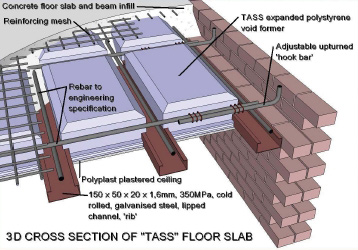TASS
THERMAL
ACOUSTIC SLAB SYSTEM
 
INTRODUCTION
With ever increasing building costs, the requirement
for rapid building and greater awareness of energy
conservation as an important aspect of building design,
expanded polystyrene (EPS) is becoming increasingly
used in modern day construction.
The TASS uses the properties of EPS -
thermal and sound insulation, lightweight,
accuracy in moulding and cost competitiveness as the
cornerstone of a patented
multi storey floor slab system.
PRODUCT DESCRIPTION
TASS is a combination of a moulded EPS block and cold
rolled steel channel to form a 'rib and block'/coffer
slab system for multi storey buildings.
The system comprises a priority high strength galvanised
steel rib which supports the high density TASS EPS
void formers.
The system is completed by the placement of reinforcing
bars between the TASS blocks in both directions, reinforcing
mesh above the blocks and concrete to fill the channels,
encapsulate the rebar and mesh to form the structure
of the floor slab.
The beams which are created by the concrete infill
and rebar in the gaps between the TASS blocks creates
a monolithic structure.
The TASS void formers are left in place and act both
as a thermal and sound insulator.
SYSTEM
APPLICATION
1)
The floor slab is designed taking into account the
span and load bearing requirements combining the variables
of rebar size and configuration, concrete beam depth
- which can be controlled by the TASS block depth,
and the horizontal floor slab and reinforcing mesh.
2) Support wall structures are built as normal.
3) Steel ribs are placed uni-directionally onto the
supporting walls. These are propped at 1,6 metre intervals
to support the wet concrete and construction loading.
4) Steel reinforcing is fitted between the TASS blocks
in both directions.
5) Steel reinforcing mesh is placed above the blocks
on EPS spacers to position the mesh near the surface
of the concrete slab.
6) If needed, formwork is placed around the perimeter
of the floor area and service ducts to confine the
concrete pour.
7) Concrete is poured to complete the slab.
8) Ceilings can be either suspended or plastered with
Polyplast, propriety EPS plaster system, available
from ABP Building Products.
TASS can be used in the following application areas:
- double storey residential
- multi storey commercial buildings
- hotels
- flats, duplexes and apartment buildings
- shopping centres
- suspended ground floor slabs
- renovations
PRODUCT
BENEFITS
Lightweight
All the components of TASS are lightweight and can
easily be installed without cranes, lifting equipment
or excessive labour.
TASS is approximately 35% lighter than competitive
concrete rib and block systems. This equates to a
saving of about 150kg/m2.
Quick and easy to
install
As the TASS components are made to close dimensional
tolerances (EPS blocks are moulded in closed moulds
and the steel channels roll formed) and lightweight
they can be quickly and easily positioned.
The TASS blocks can readily be cut with a handsaw
when full blocks do not fit and complex shapes have
to be covered.
Electrical and other services can also be cut into
the EPS and run through the blocks themselves.
Fully load bearing
During the construction phase the TASS blocks can
support workmen and equipment allowing full access
to the working area without fear of breakages or damage.
Similarly the system will support the concrete pour
provided the channels are propped at the recommended
intervals.
Thermal and sound
insulation
EPS is used extensively as a thermal insulating material
and performs this function in the slab moderating
building temperatures and reducing energy costs associated
with heating and cooling. EPS also acts as a sound
barrier and in combination with the concrete slab
mutes all sound waves that could potentially be transmitted
through loor slabs.
Fire
performance
A fire retardant grade of EPS is used to manufacture
the TASS slabs and as a result they do not add to
any existing fire hazard and will not contribute to
the development phase of a fire and will not propagate
flame.
Long life
EPS is rot, rodent and termite proof and is dimensionally
stable and will thus retain its thermal and sound
insulating properties for the life of the building.
Cost competitive
TASS is cost competitive when comparing material cost
only vs. traditional concrete systems but becomes
increasingly competitive when including the cost of
labour, equipment requirements and time.
Fewer props are needed per mtr sq for TASS when compared
to concrete systems.
Shorter supply lead
times
The concrete components of traditional 'rib and block'
systems all need lengthy cure periods after manufacture
to reach full strength often increasing supply lead
times.
The TASS EPS blocks are moulded in seconds and the
ribs cold rolled and cut to size immediately.
These alternative manufacturing methods means that
system supply lead times can be significantly reduced.
Versatility
The TASS system can span in two directions which makes
complex designs easier to configure.
Both the TASS blocks and the steel channels can be
readily cut (and welded) on site to accommodate odd
shapes and openings.
Steel formwork edges to limit the concrete can be
formed from various sizes of channel.
Skylights are easy to install by leaving out TASS
blocks and creating edge formers from cold rolled
steel sections.
PRODUCT
SPECIFICATION
System
design:
Design TASS floor slabs as per procedure laid down
in SANS10100 section 4,5 design code.
The design program used to analyse the system is commercially
available from Prokon.
TASS block dimensions:
| Sales
code |
Block
height |
Width |
Length |
Overall
slab depth |
Span |
| TASS
125 |
125mm |
410mm |
800mm
|
180mm |
5,0m |
| TASS
195 |
195mm |
410mm |
800mm
|
255mm |
6,5m |
| TASS
280 |
280mm
|
410mm |
800mm
|
340mm |
8,5m |
| TASS
365 |
365mm
|
410mm |
800mm
|
425mm |
10,5m |
EPS Density: 20gm/lt
Fire retardant: Yes
Thermal conductity: 0,038w/mK
Channels: 150 x 60 x 20 x 1.4mm 350 MPa min. yield
pre-galvanized cold rolled steel.
EPS Spacers: 35 x 40 x 40 mm high density expanded
polystyrene.
Plaster: Polyplast resin solution mixed 1:10 with
plaster sand.
For
additional information on TASS please download the
resources below.
|



